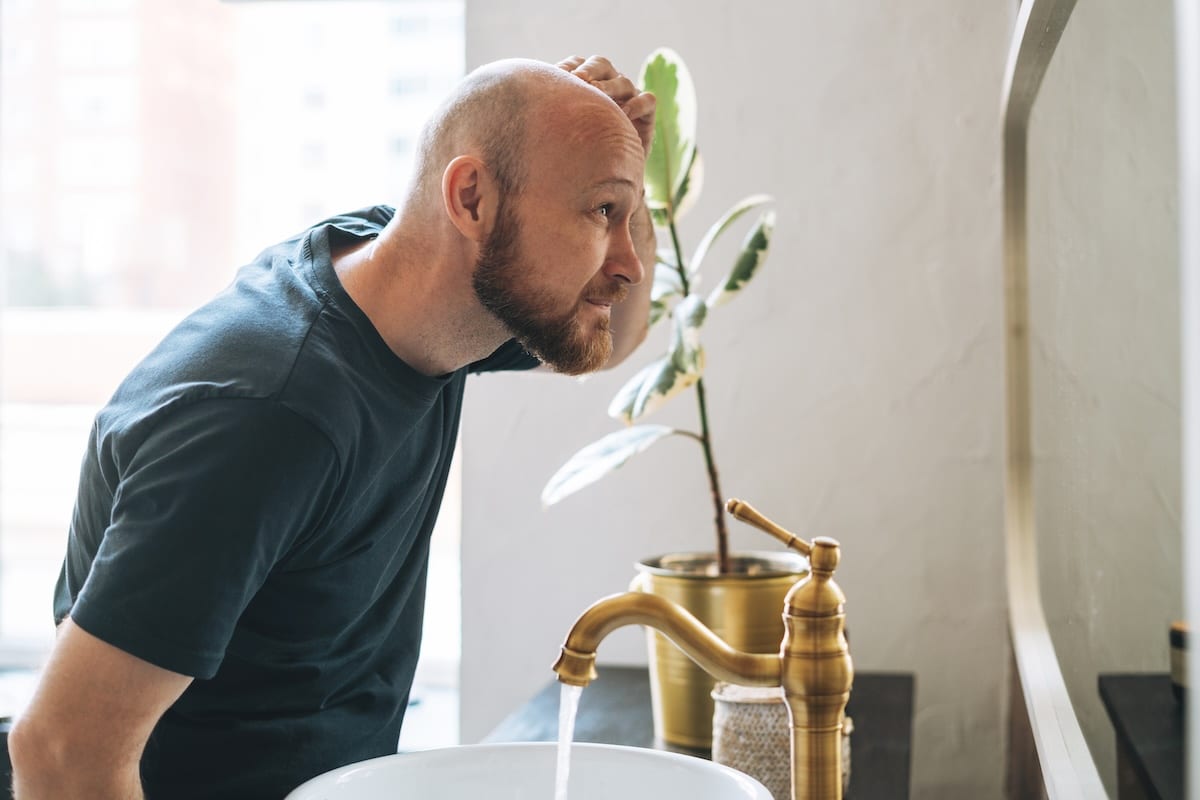To restore your natural hair and promote your natural beauty, Indian Hills Aesthetics is here to provide the best hair transplants in Tuscaloosa, custom-tailored to your specific needs.
To build hair restoration plans that actually work, the expert providers at Indian Hills Aesthetics get to the roots of hair loss for men and women of all ages. We’ll dive into your lifestyle, your health history, and your goals in your consultation. To fully understand our recommendations, let’s dive in to learn the science and the causes of hair loss.
Causes of Hair Loss
Everyone’s beauty is unique, so every hair transplant in Tuscaloosa is as well! Alopecia is a clinical blanket term used to describe hair loss. However, the root causes are unique to every person experiencing hair loss. These are the most common causes of thinning or balding:
Hats and Hairstyles
We love tight buns in Alabama, but your hair typically doesn’t. A tight braid or other hairstyle is fine on occasion. But if you’re consistently stressing your scalp with a hat or tight hairstyle, your hairline won’t stay around long!

Relax to Regrow: If you notice a thinning hairline due to traction alopecia, we recommend letting your hair down! Embracing a new look can be scary, but we’re always here to help pick out healthier hairstyles before and after hair transplants in Tuscaloosa.
Hormone Imbalances
Hormones play a huge role in many natural processes throughout your body, including hair growth. Hair loss attributed to hormones is easy to notice in postpartum and postmenopausal women. But men aren’t immune to hormone imbalances! Men experiencing low testosterone or thyroid issues are also susceptible to hair loss.
Stress
Stressful situations are a fact of life for everyone. While we covered physical stress like traction alopecia, even mental stress can cause hair loss. There’s a reason CEOs commonly experience hair loss! Luckily, as you’re able to regulate stress levels, your hair is likely to return.
Medical Conditions and Medications
Ringworms, trichotillomania, and other medical conditions can cause patchiness. Certain medications can also trigger hair loss. This is a common side effect of many acne, blood pressure, and depression medications.

What is trichotillomania? People diagnosed with trichotillomania compulsively pull and tug at their hair. Regrowth is possible, but treatment often starts with psychotherapy. For patients afflicted with this compulsion, we recommend hair transplants in Tuscaloosa after visiting with a therapist or psychiatrist.
Genetic Predispositions
If your mom or dad experienced hair loss, we have bad news for you. Sadly, the most common cause of hair loss is in our genes. These genes are most prevalent in men, but women can also suffer from genetic hair loss. Luckily, this is easily treatable with natural supplements, but for more severe cases, we’ll cover hair transplant options and build a plan for lasting results.
How Healthy Hair Grows
To fully understand your hair transplant in Tuscaloosa, it’s important to know the anatomy of your hair. The follicle and the shaft are the two main parts that make up your hair.
The Shaft
The hair shaft is made up of keratin (a protein used to strengthen your hair and nails) and has three layers: the cuticle, cortex, and medulla in coarser hair. These layers help protect your hair shaft against damage and allow it to stretch without breaking.
The Follicle
Your hair may look full of life, but the only living part of your hair is the follicle! The tunnel-shaped follicle rests in your epidermis (outer layer of skin) and stretches into the dermis (deeper layer of skin). Two sheaths—inner and outer—protect the hair follicle, enabling it to grow properly.
The Growth Cycle
Having a basic knowledge of the hair growth cycle will help you understand how your hair transplant in Tuscaloosa will remain effective. By introducing healthy hair to areas of sparse growth, we improve the growth cycle for your entire head of hair. Here are the four stages of growth that a hair transplant improves.
1. Anagen
Anagen is the active growing phase where the hair bulb is intact. Hair grows in both directions—upward and downward. During early anagen, the bulb is closest to your skin’s surface and contains an abundance of melanin (pigment). This stage is very similar to how grass grows throughout your lawn.
2. Catagen
Catagen is a brief transformative phase between anagen and telogen. It is essentially a regression phase shortly before shedding. While in this phase, the lower third of your follicle will be absorbed through natural processes. Once the root of your follicle is absorbed, the shaft will enter the final stage of the growth cycle.
3. Telogen
Telogen is also known as the resting phase. In this stage, the hair follicle connects to the hair shaft, forming “club hair.” In your brush, you can identify these hairs by the bulb on the end of each strand. The bulb keeps the hair shaft in the scalp until it finally sheds, and the process starts all over again.
4. Exogen
This is the phase where hair sheds from the scalp. This hair loss is perpetuated by regular washing and brushing. This phase can last about 2 to 5 months. As new fibers continue to grow, between 50-100 follicles fall away every day. But when you start to see double or even triple that amount, you should talk to our specialists to identify your specific type of hair loss.
Types of Hair Loss
As we understand the cause of your hair loss, we identify the specific type of hair loss to empower natural growth and the overall health of your hair. These are the most common types we treat at Indian Hills Aesthetics:
Androgenetic Alopecia
Genetic predispositions can lead to androgenetic alopecia, making it the most common type of hair loss. In the U.S. alone, this type of hair loss affects more than 50 million men and 30 million women. Androgenetic alopecia occurs in men and women very differently.

Male pattern hair loss
This type of hair loss accounts for more than 95% of hair loss in men. By age 35, over two-thirds of men have experienced some kind of hair loss. That number jumps to 85% after age 50. The first signs of this hair loss begin around the hairline and the top of the head. While some men can really rock a bald look, we recommend hair transplants in Tuscaloosa to men looking to break the cycle of hair loss in their families.

Female pattern hair loss
Hair loss of this type is less common, but hair loss of any type can be detrimental to anyone’s self-esteem. Instead of a receding hairline, female pattern baldness is commonly noticed in a gradual thinning of hair follicles throughout the scalp.
Hair Shaft Abnormalities
This is a broad generalization, but there are a variety of conditions and factors that can weaken the hair shaft. Abnormalities can stem from genetics or medical adversities equally. Breaking and further thinning are common without adequate nutrients that allow your hair to grow healthy and strong. We typically recommend starting a Nutrafol plan to improve the health of your hair prior to a transplant.
Telogen Effluvium
When large amounts of hair enter the resting phase at the same time without reentering the growing phase, it can result in fast, dramatic hair loss. Telogen effluvium is the second most common type of hair loss, and it’s one of the hardest to notice until it’s too late.
While shedding between 300–500 follicles a day is normal, little to no regrowth is a big red flag. This is commonly related to medical conditions or events that affect the hair growth cycle. Common conditions or events can include:
- Pregnancy
- Thyroid conditions
- Surgery
- Fever
- Nutrient deficiencies
Telogen effluvium usually develops three months after medical changes. Hair loss is typically temporary for medical events. However, telogen effluvium can become chronic after six or more months unless we take action.
Our Recommended Hair Transplant in Tuscaloosa
Through every consultation, our specialists decipher telltale markers in your health and lifestyle that contribute to your specific type of hair loss. We typically recommend Nutrafol first to promote the health and quality of your hair. With healthier hair follicles, your hair transplant will have a higher likelihood of success and lasting results. Instead of the dated, manual strip method, we bring the latest technology to every hair transplant in Tuscaloosa.
NeoGraft® Hair Restoration
NeoGraft is an advanced form of FUE hair transplant. This minimally invasive hair restoration treatment extracts each individual follicle and precisely places them with one simple tool. The advanced process of this treatment allows for improved efficacy, less pain, and more natural hair. In just two simple stages, this advanced hair transplant in Tuscaloosa allows us to build healthier heads of hair naturally!
The first stage of this treatment involves extracting healthy follicles with the unique extraction tool. We’ll transplant individual follicles from a full part of your hair, such as the sides or the back of your head.
In the second stage, the NeoGraft applicator precisely inserts each extracted follicle in the desired thinning or balding area on your scalp. Each transplant is completed in one fluid motion thanks to the unique pneumatic technology that drives the extraction and placement of every follicle.
The length of your hair transplant in Tuscaloosa will depend on the extent of the thinning or balding in your scalp. We count every follicle unit we extract and insert to track your hair restoration across every desired session. The required follicle unit count will typically vary depending on the severity of hair loss and the desired end result. Your specialist at Indian Hills Aesthetics will determine the required sessions as we discuss your condition and goals in your consultation.

Live a Fuller Life!
With a fuller head of hair, our patients are able to live fuller, more confident lives. So if you’re tired of hiding under that hat, we’re here to help! Start your journey to a fuller, healthier head of hair with an in-person consultation. To browse all of our treatment options, check out our procedure match tool! Indian Hills Aesthetics is excited to share what a professional hair transplant in Tuscaloosa can do for you!
